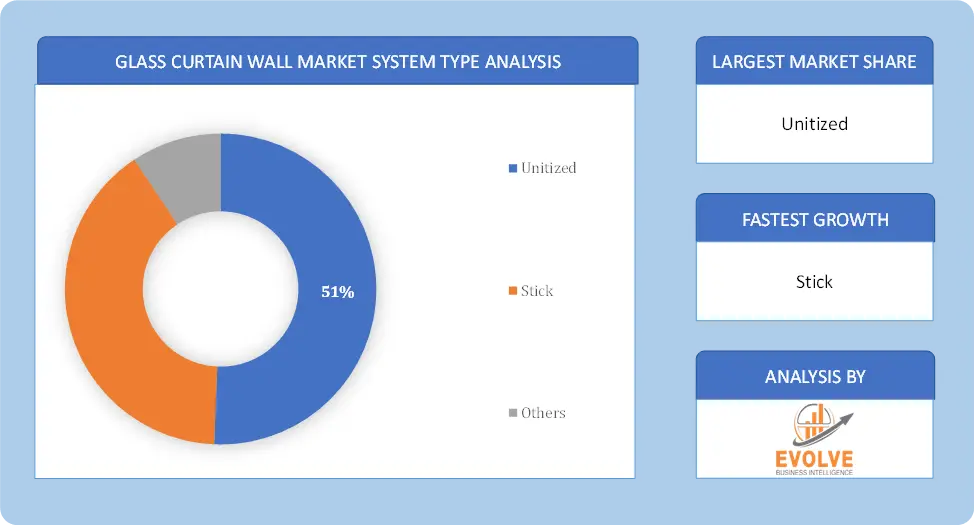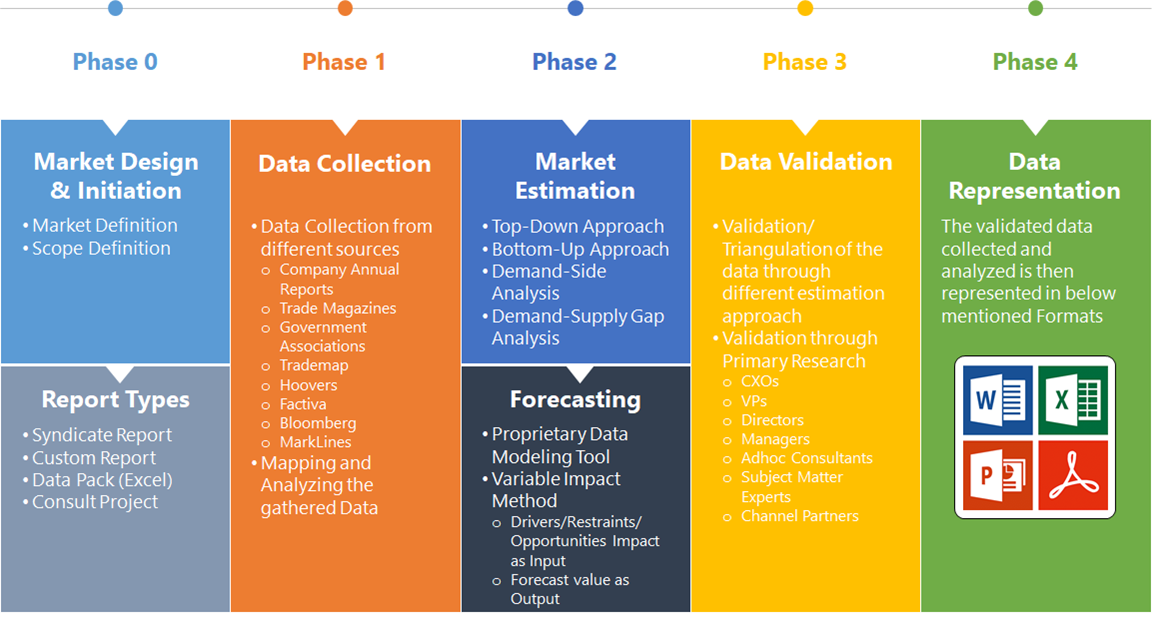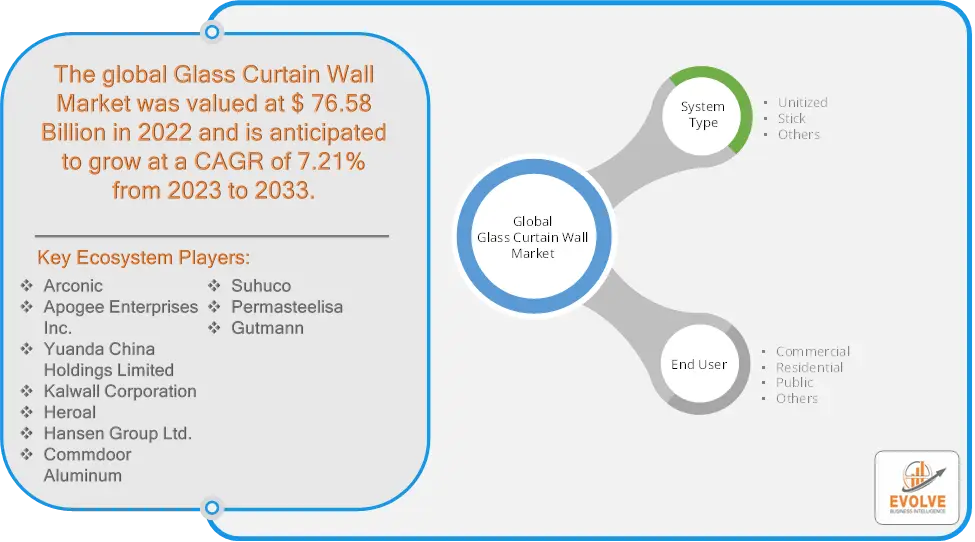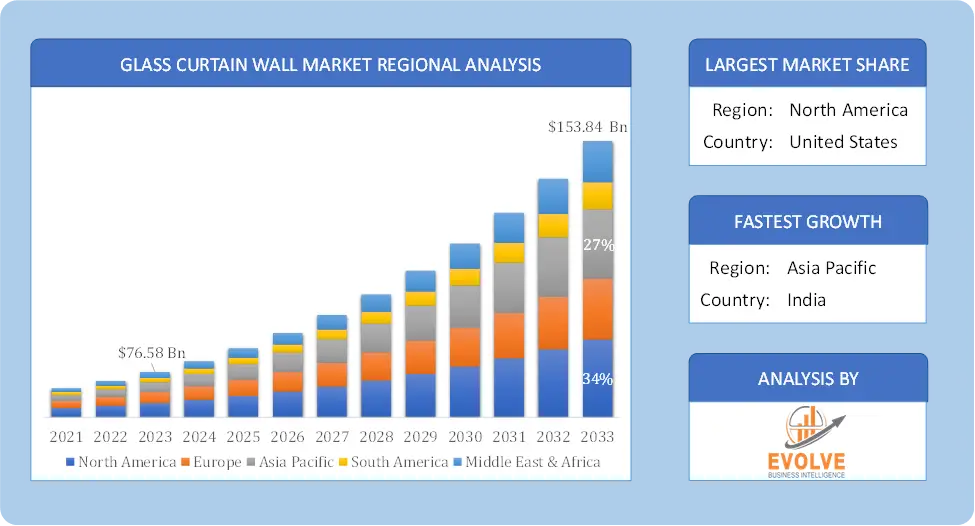Glass Curtain Wall Market Analysis and Global Forecast 2023-2033
$ 1,390.00 – $ 5,520.00Price range: $ 1,390.00 through $ 5,520.00
Glass Curtain Wall Market Research Report: Information By System Type (Unitized, Stick, Others), By End-User (Commercial, Residential, Public, Others), and by Region — Forecast till 2033
Page: 163
Glass Curtain Wall Market Overview
The Glass Curtain Wall Market Size is expected to reach USD 153.84 Billion by 2033. The Glass Curtain Wall Market industry size accounted for USD 76.58 Billion in 2023 and is expected to expand at a compound annual growth rate (CAGR) of 7.21% from 2023 to 2033. The Glass Curtain Wall Market refers to the industry focused on the design, manufacturing, installation, and maintenance of glass curtain walls, which are non-structural outer coverings of buildings. These walls are typically composed of large glass panels that are supported by a lightweight aluminum frame, allowing for a modern aesthetic and the use of natural light within the building.
The Glass Curtain Wall Market is expanding as architectural trends favor modern, sustainable, and energy-efficient building designs. They are typically used in commercial, residential, and institutional buildings to provide natural light, aesthetic appeal, and energy efficiency.
Global Glass Curtain Wall Market Synopsis
The COVID-19 pandemic had a significant impact on the Glass Curtain Wall Market. Lockdowns and restrictions disrupted the supply chain, causing delays in the production and delivery of raw materials and finished products. Many construction projects were halted or delayed due to health and safety concerns, leading to a slowdown in demand for glass curtain walls. Many companies in the market experienced reduced revenues due to decreased demand and project delays. Companies adopted remote work and virtual meetings to continue operations and maintain client relationships. There is a growing demand for buildings with better ventilation and more natural light, potentially increasing the demand for glass curtain walls in future projects. The pandemic has heightened awareness of environmental sustainability, leading to a preference for energy-efficient and eco-friendly building materials. Economic recovery packages and infrastructure investments by governments may stimulate the construction industry and, in turn, the glass curtain wall market.
Glass Curtain Wall Market Dynamics
The major factors that have impacted the growth of Glass Curtain Wall Market are as follows:
Drivers:
Ø Technological Advancements
Innovations in glass manufacturing, such as smart glass that can change transparency levels, enhance the functionality and appeal of glass curtain walls. Improvements in frame materials and construction techniques increase the durability and performance of curtain wall systems. Rapid urbanization and growth of metropolitan areas lead to increased construction of commercial, residential, and public buildings. Governments and private sectors invest in infrastructure projects that incorporate modern architectural designs, including glass curtain walls. Modern glass curtain walls incorporate safety features such as impact resistance, fire resistance, and improved structural integrity.
Restraint:
- Perception of High Initial Costs and Economic Uncertainty
The installation of glass curtain walls involves significant upfront costs, including materials, labor, and installation. High initial investment may deter some developers, especially in cost-sensitive markets or smaller projects. Economic downturns and fluctuations in the construction industry can lead to reduced investment in new building projects, impacting demand for glass curtain walls. Financial instability can delay or cancel construction projects, affecting market growth.
Opportunity:
⮚ Sustainable and Green Building Practices
Increasing emphasis on environmentally friendly and sustainable construction practices provides opportunities for energy-efficient glass curtain walls. Certifications like LEED and BREEAM promote the use of sustainable materials, driving demand for advanced glass technologies that reduce carbon footprints. The trend of retrofitting and renovating existing buildings to improve energy efficiency and aesthetics provides opportunities for glass curtain wall installations. Older buildings undergoing modernization can benefit from the enhanced performance and appearance of new glass curtain wall systems.
Glass Curtain Wall Market Segment Overview
By System Type
 Based on System Type, the market is segmented based on Unitized, Stick and Others. The unitized dominant the market. The finished product’s quality is guaranteed since the unitized system is constructed in a controlled setting away from the site of use. At the construction site, the glass panels are then brought and put together. But only high-volume projects may employ the method because it needs specialized cranes to be installed.
Based on System Type, the market is segmented based on Unitized, Stick and Others. The unitized dominant the market. The finished product’s quality is guaranteed since the unitized system is constructed in a controlled setting away from the site of use. At the construction site, the glass panels are then brought and put together. But only high-volume projects may employ the method because it needs specialized cranes to be installed.
By End User
Based on End User, the market segment has been divided into Commercial, Residential, Public and Others. The commercial segment dominant the market. Stadiums, public structures, and various transit facilities including train stations, bus terminals, and airports are all included in the commercial section. To save energy and meet various legal requirements, these venues are rapidly adopting green construction norms. Because of this, installing glass curtain walls there offers a great potential for energy savings.
Global Glass Curtain Wall Market Regional Analysis
Based on region, the global Glass Curtain Wall Market has been divided into North America, Europe, Asia-Pacific, the Middle East & Africa, and Latin America. North America is projected to dominate the use of the Glass Curtain Wall Market followed by the Asia-Pacific and Europe regions.
 Global Glass Curtain Wall North America Market
Global Glass Curtain Wall North America Market
North America holds a dominant position in the Glass Curtain Wall Market. the North America market is still substantial, driven by commercial construction and renovation projects. A focus on sustainable and energy-efficient buildings is also contributing to growth. Adoption of advanced glass technologies for energy efficiency and smart features. Strong focus on green building certifications such as LEED and significant investments in commercial real estate and infrastructure projects.
Global Glass Curtain Wall Asia-Pacific Market
The Asia-Pacific region has indeed emerged as the fastest-growing market for the Glass Curtain Wall Market industry. This region is currently dominating the global glass curtain wall market, with countries like China and India leading the charge. Rapid urbanization, infrastructure development, and a growing middle class are driving demand. Fast-paced urban development and growing metropolitan areas. Increasing investments in commercial and residential construction due to economic expansion and high growth potential in countries like China, India, and Southeast Asian nations.
Competitive Landscape
The global Glass Curtain Wall Market is highly competitive, with numerous players offering a wide range of software solutions. The competitive landscape is characterized by the presence of established companies, as well as emerging startups and niche players. To increase their market position and attract a wide consumer base, the businesses are employing various strategies, such as product launches, and strategic alliances.
Prominent Players:
- Arconic
- Apogee Enterprises Inc.
- Yuanda China Holdings Limited
- Kalwall Corporation
- Heroal
- Hansen Group Ltd.
- Commdoor Aluminum
- Suhuco
- Permasteelisa
- Gutmann
Key Development
In February 2021, Vitro Architectural Glass launched Solarban R77 solar control, low-emissivity (Low-E) glass that combines a sharp, neutrally reflective silver-blue aesthetic along with the building-code-friendly solar performance.
In January 2023, AGC Inc. partnered with the Japanese construction company Shimizu Corporation to develop a new type of glass curtain wall that is resistant to earthquakes and typhoons.
Scope of the Report
Global Glass Curtain Wall Market, by System Type
- Unitized
- Stick
- Others
Global Glass Curtain Wall Market, by End User
- Commercial
- Residential
- Public
- Others
Global Glass Curtain Wall Market, by Region
- North America
- US
- Canada
- Mexico
- Europe
- UK
- Germany
- France
- Italy
- Spain
- Benelux
- Nordic
- Rest of Europe
- Asia Pacific
- China
- Japan
- South Korea
- Indonesia
- Austalia
- Malaysia
- India
- Rest of Asia Pacific
- South America
- Brazil
- Argentina
- Rest of South America
- Middle East & Africa
- Saudi Arabia
- UAE
- Egypt
- South Africa
- Rest of Middle East & Africa
| Parameters | Indicators |
|---|---|
| Market Size | 2033: $153.84 Billion |
| CAGR | 7.21% CAGR (2023-2033) |
| Base year | 2022 |
| Forecast Period | 2023-2033 |
| Historical Data | 2021 |
| Report Coverage | Revenue Forecast, Competitive Landscape, Growth Factors, and Trends |
| Key Segmentations | Product Type, End User |
| Geographies Covered | North America, Europe, Asia-Pacific, Latin America, Middle East, Africa |
| Key Vendors | Arconic, Apogee Enterprises Inc., Yuanda China Holdings Limited, Kalwall Corporation, Heroal, Hansen Group Ltd., Commdoor Aluminum, Suhuco, Permasteelisa and Gutmann. |
| Key Market Opportunities | • Sustainable and Green Building Practices • Retrofitting and Renovation Projects |
| Key Market Drivers | • Technological Advancements • Urbanization and Infrastructure Development |
REPORT CONTENT BRIEF:
- High-level analysis of the current and future Glass Curtain Wall Market trends and opportunities
- Detailed analysis of current market drivers, restraining factors, and opportunities in the future
- Glass Curtain Wall Market historical market size for the year 2021, and forecast from 2023 to 2033
- Glass Curtain Wall Market share analysis at each product level
- Competitor analysis with detailed insight into its product segment, Government & Defense strength, and strategies adopted.
- Identifies key strategies adopted including product launches and developments, mergers and acquisitions, joint ventures, collaborations, and partnerships as well as funding taken and investment done, among others.
- To identify and understand the various factors involved in the global Glass Curtain Wall Market affected by the pandemic
- To provide a detailed insight into the major companies operating in the market. The profiling will include the Government & Defense health of the company’s past 2-3 years with segmental and regional revenue breakup, product offering, recent developments, SWOT analysis, and key strategies.
Press Release

Global Pharmaceutical Manufacturing Market to Reach $1.38 Trillion by 2035 with 7.35% CAGR, New Research Shows

The Global Mammography Market Is Estimated To Record a CAGR of Around 10.29% During The Forecast Period

Glue Stick Market to Reach USD 2.35 Billion by 2034

Podiatry Service Market to Reach USD 11.88 Billion by 2034

Microfluidics Technology Market to Reach USD 32.58 Billion by 2034

Ferric Chloride Market to Reach USD 10.65 Billion by 2034

Family Practice EMR Software Market to Reach USD 21.52 Billion by 2034

Electric Hairbrush Market to Reach USD 15.95 Billion by 2034

Daily Bamboo Products Market to Reach USD 143.52 Billion by 2034

Cross-border E-commerce Logistics Market to Reach USD 112.65 Billion by 2034
Frequently Asked Questions (FAQ)
What is the study period of this market?
The study period of the global Glass Curtain Wall Market is 2021- 2033
What is the growth rate of the global Glass Curtain Wall Market?
The global Glass Curtain Wall Market is growing at a CAGR of 7.21% over the next 10 years
Which region has the highest growth rate in the market of Glass Curtain Wall Market?
Asia Pacific is expected to register the highest CAGR during 2023-2033
Which region has the largest share of the global Glass Curtain Wall Market?
North America holds the largest share in 2022
Who are the key players in the global Glass Curtain Wall Market?
Arconic, Apogee Enterprises Inc., Yuanda China Holdings Limited, Kalwall Corporation, Heroal, Hansen Group Ltd., Commdoor Aluminum, Suhuco, Permasteelisa and Gutmann are the major companies operating in the market.
Do you offer Post Sale Support?
Yes, we offer 16 hours of analyst support to solve the queries
Do you sell particular sections of a report?
Yes, we provide regional as well as country-level reports. Other than this we also provide a sectional report. Please get in contact with our sales representatives
Table of Content
Chapter 1. Executive Summary Chapter 2. Scope Of The Study 2.1. Market Definition 2.2. Scope Of The Study 2.2.1. Objectives of Report Chapter 3. Evolve BI Methodology Chapter 4. Market Insights and Trends 4.1. Supply/ Value Chain Analysis 4.2. Porter’s Five Forces Analysis 4.2.1. Threat Of New Entrants 4.2.2. Bargaining Power Of Buyers 4.2.3. Bargaining Power Of Suppliers 4.2.4. Threat Of Substitutes 4.2.5. Industry Rivalry 4.3. Impact of COVID-19 on Glass Curtain Wall Market 4.3.1. Impact on Market Size 4.3.2. End User Trend, Preferences, and Budget Impact 4.3.3. Regulatory Framework/Government Policies 4.3.4. Key Players Strategy to Tackle Negative Impact 4.3.5. Opportunity Window Chapter 5. Market Dynamics 5.1. Introduction 5.2. DRO Analysis 5.2.1. Drivers 5.2.2. Restraints 5.2.3. Opportunities Chapter 6. Global Glass Curtain Wall Market, By System Type 6.1. Introduction 6.2. Unitized 6.3. Stick 6.3. Others Chapter 7. Global Glass Curtain Wall Market, By End-User 7.1. Introduction 7.2. Commercial 7.3. Residential 7.4. Public 7.5. Others Chapter 8. Global Glass Curtain Wall Market, By Region 8.1. Introduction 8.2. North America 8.2.1. Introduction 8.2.2. Driving Factors, Opportunity Analyzed and Key Trends 8.2.3. Market Size and Forecast, By Country, 2020 - 2028 8.2.4. Market Size and Forecast, By System Type, 2020 - 2028 8.2.5. Market Size and Forecast, By End-User, 2020 – 2028 8.2.6. US 8.2.6.1. Introduction 8.2.6.2. Driving Factors, Opportunity Analyzed and Key Trends 8.2.6.3. Market Size and Forecast, By System Type, 2020 - 2028 8.2.6.4. Market Size and Forecast, By End-User, 2020 - 2028 8.2.7. Canada 8.2.7.1. Introduction 8.2.7.2. Driving Factors, Opportunity Analyzed and Key Trends 8.2.7.3. Market Size and Forecast, By System Type, 2020 - 2028 8.2.7.4. Market Size and Forecast, By End-User, 2020 - 2028 8.3. Europe 8.3.1. Introduction 8.3.2. Driving Factors, Opportunity Analyzed and Key Trends 8.3.3. Market Size and Forecast, By Country, 2020 - 2028 8.3.4. Market Size and Forecast, By System Type, 2020 - 2028 8.3.5. Market Size and Forecast, By End-User, 2020 – 2028 8.3.6. Germany 8.3.6.1. Introduction 8.3.6.2. Driving Factors, Opportunity Analyzed and Key Trends 8.3.6.3. Market Size and Forecast, By System Type, 2020 - 2028 8.3.6.4. Market Size and Forecast, By End-User, 2020 - 2028 8.3.7. France 8.3.7.1. Introduction 8.3.7.2. Driving Factors, Opportunity Analyzed and Key Trends 8.3.7.3. Market Size and Forecast, By System Type, 2020 - 2028 8.3.7.4. Market Size and Forecast, By End-User, 2020 - 2028 8.3.8. UK 8.3.8.1. Introduction 8.3.8.2. Driving Factors, Opportunity Analyzed and Key Trends 8.3.8.3. Market Size and Forecast, By System Type, 2020 - 2028 8.3.8.4. Market Size and Forecast, By End-User, 2020 - 2028 8.3.9. Italy 8.3.9.1. Introduction 8.3.9.2. Driving Factors, Opportunity Analyzed and Key Trends 8.3.9.3. Market Size and Forecast, By System Type, 2020 - 2028 8.3.9.4. Market Size and Forecast, By End-User, 2020 - 2028 8.3.10. Rest Of Europe 8.3.10.1. Introduction 8.3.10.2. Driving Factors, Opportunity Analyzed and Key Trends 8.3.10.3. Market Size and Forecast, By System Type, 2020 - 2028 8.3.10.4. Market Size and Forecast, By End-User, 2020 - 2028 8.4. Asia-Pacific 8.4.1. Introduction 8.4.2. Driving Factors, Opportunity Analyzed and Key Trends 8.4.3. Market Size and Forecast, By Country, 2020 - 2028 8.4.4. Market Size and Forecast, By System Type, 2020 - 2028 8.4.5. Market Size and Forecast, By End-User, 2020 - 2028 8.4.6. China 8.4.6.1. Introduction 8.4.6.2. Driving Factors, Opportunity Analyzed and Key Trends 8.4.6.3. Market Size and Forecast, By System Type, 2020 - 2028 8.4.6.4. Market Size and Forecast, By End-User, 2020 - 2028 8.4.7. India 8.4.7.1. Introduction 8.4.7.2. Driving Factors, Opportunity Analyzed and Key Trends 8.4.7.3. Market Size and Forecast, By System Type, 2020 - 2028 8.4.7.4. Market Size and Forecast, By End-User, 2020 - 2028 8.4.8. Japan 8.4.8.1. Introduction 8.4.8.2. Driving Factors, Opportunity Analyzed and Key Trends 8.4.8.3. Market Size and Forecast, By System Type, 2020 - 2028 8.4.8.4. Market Size and Forecast, By End-User, 2020 - 2028 8.4.9. South Korea 8.4.9.1. Introduction 8.4.9.2. Driving Factors, Opportunity Analyzed and Key Trends 8.4.9.3. Market Size and Forecast, By System Type, 2020 - 2028 8.4.9.4. Market Size and Forecast, By End-User, 2020 - 2028 8.4.10. Rest Of Asia-Pacific 8.4.10.1. Introduction 8.4.10.2. Driving Factors, Opportunity Analyzed and Key Trends 8.4.10.3. Market Size and Forecast, By System Type, 2020 - 2028 8.4.10.4. Market Size and Forecast, By End-User, 2020 - 2028 8.5. Rest Of The World (RoW) 8.5.1. Introduction 8.5.2. Driving Factors, Opportunity Analyzed and Key Trends 8.5.3. Market Size and Forecast, By System Type, 2020 - 2028 8.5.4. Market Size and Forecast, By End-User, 2020 - 2028 8.5.5. Market Size and Forecast, By Region, 2020 - 2028 8.5.6. South America 8.5.6.1. Introduction 8.5.6.2. Driving Factors, Opportunity Analyzed and Key Trends 8.5.6.3. Market Size and Forecast, By System Type, 2020 - 2028 8.5.6.4. Market Size and Forecast, By End-User, 2020 - 2028 8.5.7. Middle East and Africa 8.5.7.1. Introduction 8.5.7.2. Driving Factors, Opportunity Analyzed and Key Trends 8.5.7.3. Market Size and Forecast, By System Type, 2020 - 2028 8.5.7.4. Market Size and Forecast, By End-User, 2020 - 2028 Chapter 9. Competitive Landscape 9.1. Introduction 9.2. Vendor Share Analysis, 2020/Key Players Positioning, 2020 Chapter 10. Company Profiles 10.1. Arconic 10.1.1. Business Overview 10.1.2. Financial Analysis 10.1.3. Product Portfolio 10.1.4. Recent Development and Strategies Adopted 10.1.5. SWOT Analysis 10.2. Apogee Enterprises Inc. 10.2.1. Business Overview 10.2.2. Financial Analysis 10.2.3. Product Portfolio 10.2.4. Recent Development and Strategies Adopted 10.2.5. SWOT Analysis 10.3. Yuanda China Holdings Limited 10.3.1. Business Overview 10.3.2. Financial Analysis 10.3.3. Product Portfolio 10.3.4. Recent Development and Strategies Adopted 10.3.5. SWOT Analysis 10.4. Kalwall Corporation 10.4.1. Business Overview 10.4.2. Financial Analysis 10.4.3. Product Portfolio 10.4.4. Recent Development and Strategies Adopted 10.4.5. SWOT Analysis 10.5. Heroal 10.5.1. Business Overview 10.5.2. Financial Analysis 10.5.3. Product Portfolio 10.5.4. Recent Development and Strategies Adopted 10.5.5. SWOT Analysis 10.6. Hansen Group Ltd. 10.6.1. Business Overview 10.6.2. Financial Analysis 10.6.3. Product Portfolio 10.6.4. Recent Development and Strategies Adopted 10.6.5. SWOT Analysis 10.7. Commdoor Aluminum 10.7.1. Business Overview 10.7.2. Financial Analysis 10.7.3. Product Portfolio 10.7.4. Recent Development and Strategies Adopted 10.7.5. SWOT Analysis 10.8. Suhuco 10.8.1. Business Overview 10.8.2. Financial Analysis 10.8.3. Product Portfolio 10.8.4. Recent Development and Strategies Adopted 10.8.5. SWOT Analysis 10.9. Permasteelisa 10.9.1. Business Overview 10.9.2. Financial Analysis 10.9.3. Product Portfolio 10.9.4. Recent Development and Strategies Adopted 10.9.5. SWOT Analysis 10.10. Gutmann 10.10.1. Business Overview 10.10.2. Financial Analysis 10.10.3. Product Portfolio 10.10.4. Recent Development and Strategies Adopted 10.10.5. SWOT Analysis Chapter 11. Key Takeaways
Connect to Analyst
Research Methodology









